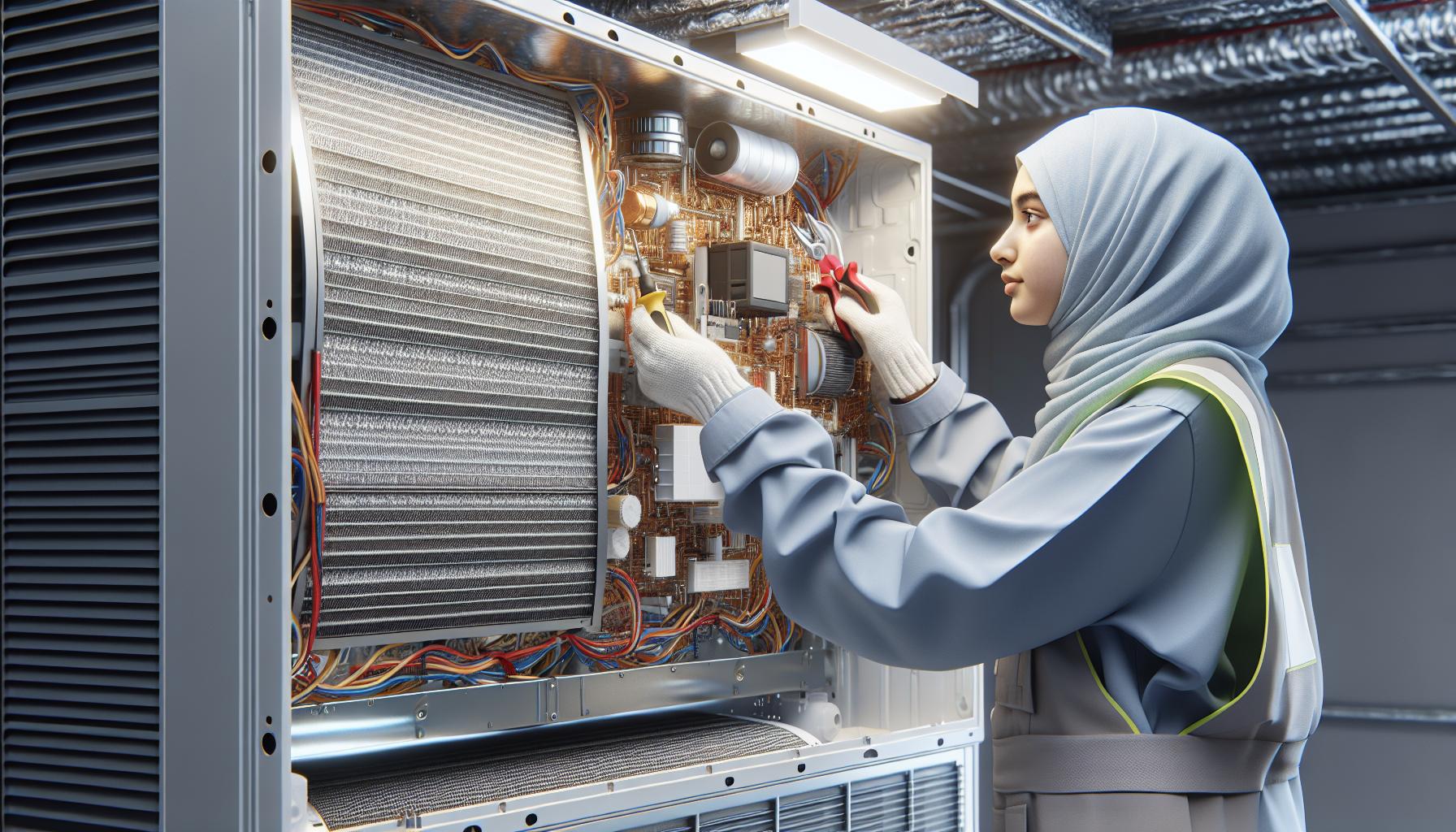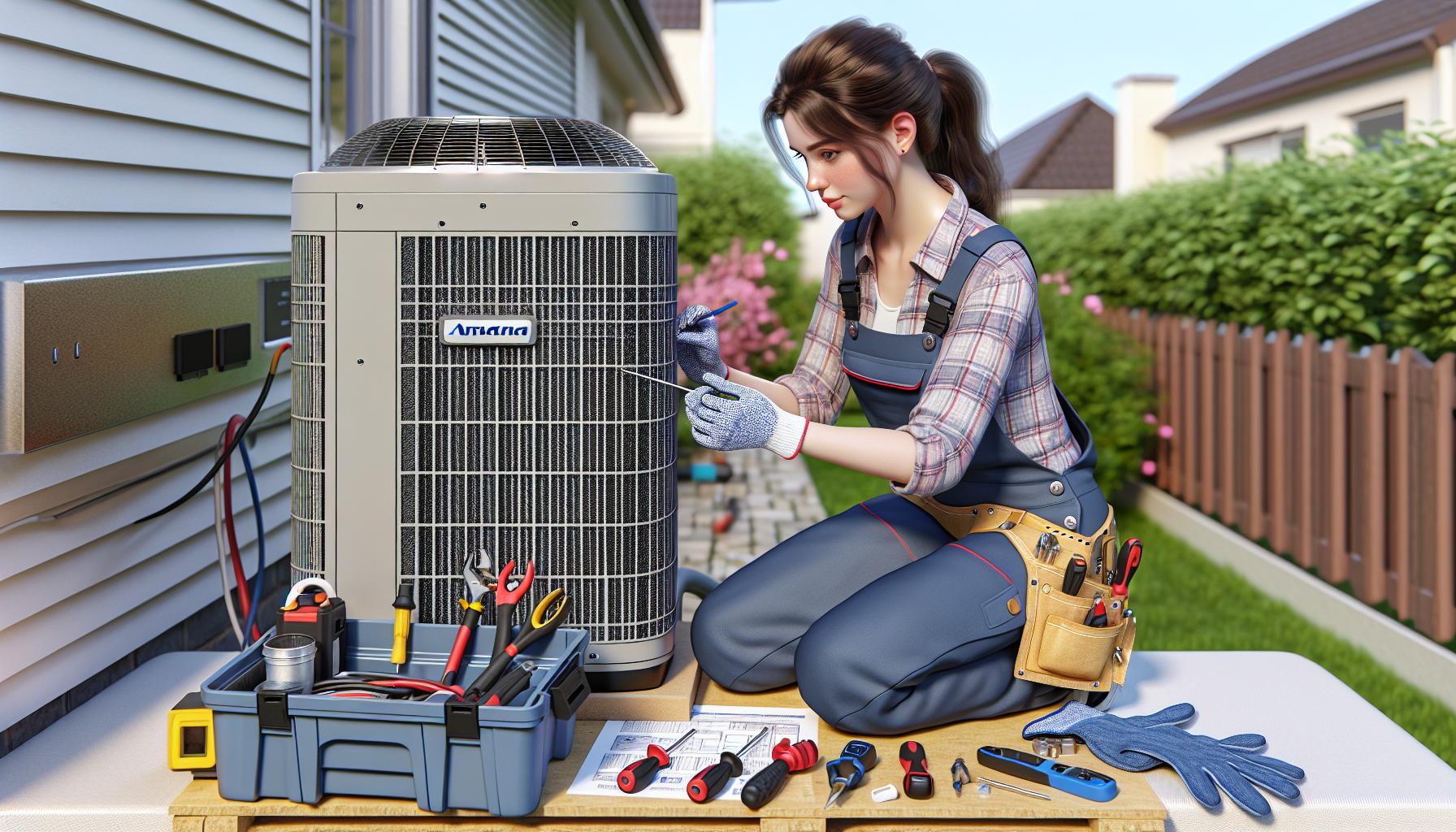Struggling with an Amana air conditioner that’s not cooling can be frustrating, especially during those hot days when you need relief the most. It’s a common issue that might not be as catastrophic as it seems. From power outages to tripped circuit breakers, several factors could be causing your unit’s lack of chill.
Understanding the root of the problem is key. Your AC might be operational, but if it’s not blowing cold air, it could be down to something as simple as a dirty air filter or as complex as a compromised compressor. Let’s investigate into the possible reasons behind this chilling dilemma and find out how to get your cool back.
Understanding the Basics of an Amana Air Conditioner
How Does an Amana Air Conditioner Work?
An Amana air conditioner operates by extracting heat from inside your home and transferring it outdoors. It’s a continuous cycle that includes compressing refrigerant to cool down the air, which circulates back into the room as cold, refreshing air. Key steps involve the refrigerant absorbing heat as it turns from a liquid to a gas in the evaporator, then releasing the heat outdoors as it reverts back to a liquid in the condenser.
Common Components of an Amana Air Conditioner
Your Amana air conditioner comprises several essential components:
- Compressor: The heart of the system, pressurizing refrigerant to ensure it moves effectively through the system.
- Condenser Coil: Releases heat from the refrigerant into the outside air.
- Evaporator Coil: Absorbs heat from the air in your home.
- Blower Motor: Drives air through the system and circulates it back into the room.
- Thermostat: Monitors and controls the temperature setting in your space.
- Air Filter: Captures dust and other particles to maintain air quality.
Each part works in tandem to maintain a cool and comfortable environment.
Potential Issues with an Amana Air Conditioner
Several factors may impact your Amana air conditioner’s ability to cool:
- Compressor failure: Without the compressor, refrigerant cannot move and cool air efficiently.
- Low refrigerant levels: Refrigerant is essential for the heat exchange process. Insufficient levels lead to diminished cooling.
- Faulty fan blades or motors: A malfunctioning fan compromises air circulation.
- Clogged air filters: Restricts airflow, reducing efficiency and straining the system.
- Frozen evaporator coils: Typically occurs with poor airflow from a dirty filter or low refrigerant levels.
Regular maintenance and prompt repairs will help to mitigate these issues, maintaining your air conditioner’s performance and extending its lifespan.
Troubleshooting Steps to Identify Why Your Amana Air Conditioner is Not Getting Cold

Checking the Thermostat Settings
First things first, ensure your Amana air conditioner’s thermostat settings are correctly adjusted. Your thermostat must be set to “cool” rather than “heat” or “off” to initiate cooling. Check the temperature setting to confirm that it’s lower than the current room temperature. If not, your AC won’t start its cooling cycle. Occasionally, someone may have unintentionally altered the settings, or a power outage might have reset the thermostat.
Inspecting the Air Filters
A primary cause for your air conditioner not cooling could be a dirty air filter. A clogged air filter restricts airflow, compromising system efficiency and performance. Air filters should be periodically checked and changed to maintain air quality and protect the AC components from dirt and debris. Energy.gov reports that changing a clogged filter could cut energy consumption by up to 15%. Turn off the AC unit, remove the air filter, and if it’s dirty, replace it to prevent decreased cooling capacity and potential system shutdown.
Ensuring Proper Airflow
Airflow problems within your HVAC system can significantly affect its cooling performance. Ensure that all registers and vents are open and unobstructed by furniture or curtains. Also, check the outdoor unit to verify that there’s no debris, such as leaves or dirt, blocking the air inlet or outlet. Restricted airflow can lead to a range of issues, from inefficient cooling to a complete breakdown of the air conditioner.
Verifying the Condenser Unit
The condenser unit, typically located outside your home, is vital for dissipating heat from the refrigerant and releasing it outdoors. A clean condenser coil is essential for this process to function efficiently. Inspect your condenser unit for signs of dirt accumulation or damage. Common issues such as a dirty coil, a frozen coil, or refrigerant leaks all contribute to poor cooling performance.
Checking the Refrigerant Levels
Refrigerant is the lifeblood of your air conditioning system; without the correct amount, your unit cannot cool effectively. Low refrigerant levels due to leaks or insufficient charge can cause your Amana air conditioner to blow warm air. If you suspect a refrigerant issue, it’s crucial to contact a professional HVAC technician to address this, as handling refrigerant requires expertise and compliance with environmental regulations.
Possible Reasons for a Not Cooling Amana Air Conditioner

Dirty or Clogged Air Filters
One primary reason your Amana air conditioner isn’t cooling might be due to dirty or clogged air filters. Air filters are crucial for maintaining clean airflow and efficient operation. When they become clogged with dust, pollen, and other debris, airflow is significantly hindered. This blockage can cause the unit to work harder, leading to less effective cooling and potential system shutdowns. To keep your air conditioner running smoothly, ensure you replace or clean air filters as recommended by the manufacturer or your HVAC professional. Remember, Energy.gov states replacing a dirty, clogged filter can reduce your air conditioner’s energy consumption by as much as 15%.
Malfunctioning Thermostat
A thermostat acting up can be another cause for cooling woes. It’s the command center that tells your AC when and how to cool; hence, if it’s not functioning properly, cooling performance will suffer. Check your thermostat settings first it might be set incorrectly. If it is set right, yet issues persist, the thermostat might be failing to send the correct signals to your air conditioning unit. This miscommunication can result in the AC not kicking on when it should or not reaching the desired temperature.
Blocked or Damaged Air Ducts
Your Amana air conditioner relies on a network of air ducts to distribute cool air throughout your space. If ducts are blocked with debris, or worse, damaged, your system’s airflow can be disrupted. This disruption affects the efficiency of your AC, leading to poor cooling performance and uneven temperature distribution. Inspecting and cleaning your ductwork or having it professionally serviced can open the pathway for cool air to effectively reach every corner of your home.
Faulty Condenser Unit
The condenser unit is a vital component of your AC system, responsible for releasing heat from the refrigerant and cooling the indoor air. A faulty condenser is often signaled by unusual noises or visible signs of damage. If the condenser coils are dirty or the unit is failing, it won’t expel heat as effectively, leaving your indoor air warmer than desired. Regular maintenance is key to ensuring your condenser unit remains in optimal working condition, reducing the likelihood of breakdowns.
Refrigerant Leak
Refrigerant is the lifeblood of your air conditioning system, and if there’s a leak, the consequences can include reduced cooling capacity and potential damage to the compressor. Indications of a refrigerant leak include hissing sounds from the AC unit or ice formation on the coils. If you notice any of these signs, it’s essential to halt operation and call a licensed HVAC professional to handle the leak safely and replenish the refrigerant to the correct level.
Steps to Resolve the Issue and Get Your Amana Air Conditioner Cold Again

Cleaning or Replacing Air Filters
Dirty or clogged air filters hamper the airflow of your Amana air conditioner which can significantly reduce its cooling efficiency. A clean filter allows for optimal air circulation, enhancing the unit’s performance. Follow these steps to address the filter:
- Turn off your air conditioner.
- Open the access panel to find the filter, typically located near the return air duct.
- Remove the dirty filter.
- If reusable, clean it with water; if disposable, replace it with a new one.
- Reinsert the filter, close the panel, and restart your system.
Regular cleaning or replacement of air filters is a simple yet effective measure that can restore the full cooling capacity of your air conditioner.
Calibrating or Replacing the Thermostat
An improperly calibrated thermostat could be misreading the actual temperature of your space, leading to inadequate cooling. To calibrate or reset the thermostat:
- Ensure it’s levelled correctly.
- Clean the interior of the thermostat to remove any dust or debris.
- Adjust the calibration screw or dial according to the manufacturer’s instructions.
- If recalibration fails, consider replacing the thermostat entirely to ensure accurate temperature control.
In some cases, thermostat failure is indicated by a code such as F5 or F2; when presented with these errors, replacement is often the best course of action.
Clearing Obstructions in Air Ducts
Blocked or damaged air ducts can significantly impair the efficiency of your air conditioning system. To clear obstructions:
- Visually inspect accessible ductwork for blockages.
- Remove any visible debris or obstructions to allow free flow of cool air.
- Consider hiring a professional if the blockage is extensive or if there’s damage to the ducts.
- Regular maintenance will prevent future blockages and maintain efficient system operation.
Unobstructed air ducts ensure that cool air is evenly and effectively distributed throughout your space.
Repairing or Replacing the Condenser Unit
The condenser unit plays a critical role in the heat exchange process. Any issues with this unit could lead to your Amana air conditioner not getting cold. Solutions may include:
- Removing debris around the condenser to ensure unimpeded air flow.
- Checking for damaged parts such as coils or fan blades within the condenser unit.
- Consulting a professional to repair or replace faulty components if the unit is not functioning properly.
- Ensuring regular servicing to keep the condenser unit in peak condition.
A fully operational condenser unit is essential for the air conditioner’s ability to cool your home effectively.
Sealing the Refrigerant Leak
A refrigerant leak is a serious issue that impacts the cooling power of your air conditioner. To address a leak:
- Look for signs of refrigerant leakage such as oil stains or hissing noises.
- Engage a certified technician to perform a leak test, repair the leak, and recharge the refrigerant to the appropriate level.
- Do not attempt to refill refrigerant yourself; handling these substances requires professional expertise.
- Ongoing checks for leaks can prevent future episodes of inefficient cooling.
Promptly sealing a refrigerant leak ensures your air conditioner maintains its cold air production and operates efficiently.
Conclusion
Your Amana air conditioner’s ability to keep you cool hinges on proper care and timely troubleshooting. Remember to stay vigilant for signs of compressor issues, refrigerant shortages, and airflow obstructions. By tackling these problems head-on, you’ll ensure your unit runs smoothly and efficiently. Regular checks and maintenance are your best defence against unexpected breakdowns. If you’re facing persistent cooling issues, don’t hesitate to consult a professional for a thorough inspection and expert repair. With these steps, you’ll be back to enjoying a cool, comfortable home in no time.
Speaking of air filters, you might be interested in Air filter. Additionally, if you’re curious about how thermostats control your home’s temperature, check out Thermostat on Wikipedia. For those wanting to delve deeper into the workings of an air conditioner, the article on Air conditioning is a great resource. Lastly, if you want to understand more about the heart of your AC unit, the <a href="https://en
Related Posts:
- Identifying the Problem: Signs Your Air Conditioner…
- Fixing an RV Water Heater Switch: Troubleshooting Tips
- Understanding HVAC Filters: A Guide for Homeowners
- Troubleshooting Guide: Why Your Air Conditioner…
- Air Conditioner Woes: Why Isn't My AC Cooling?
- Easy LG Filter Cleaning: How to Maintain Your Air…
